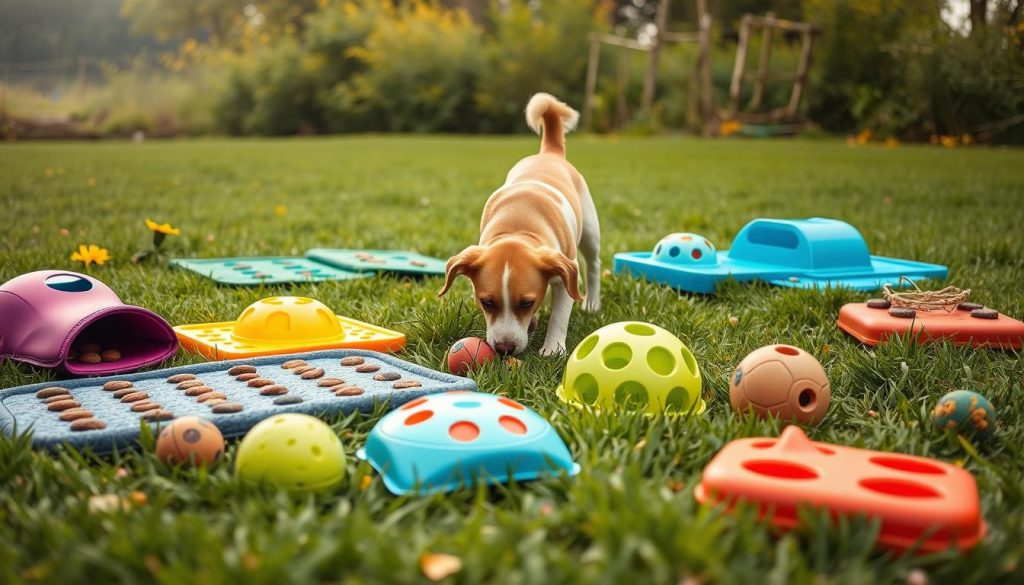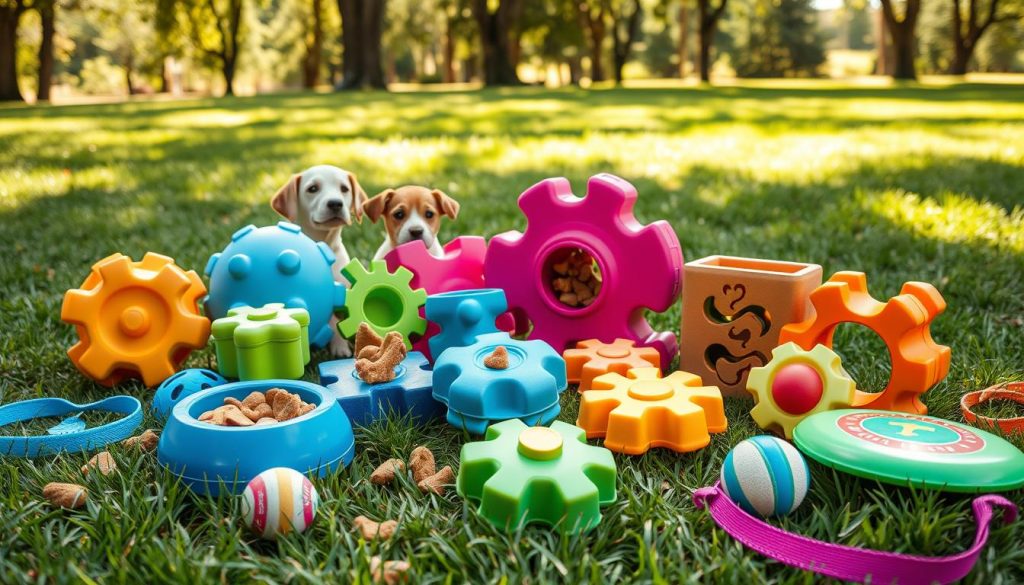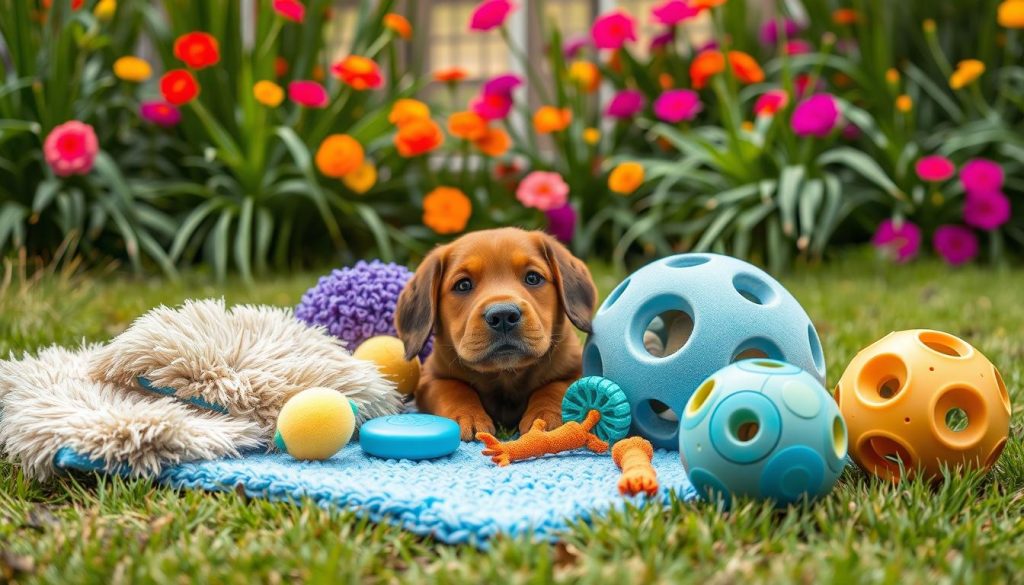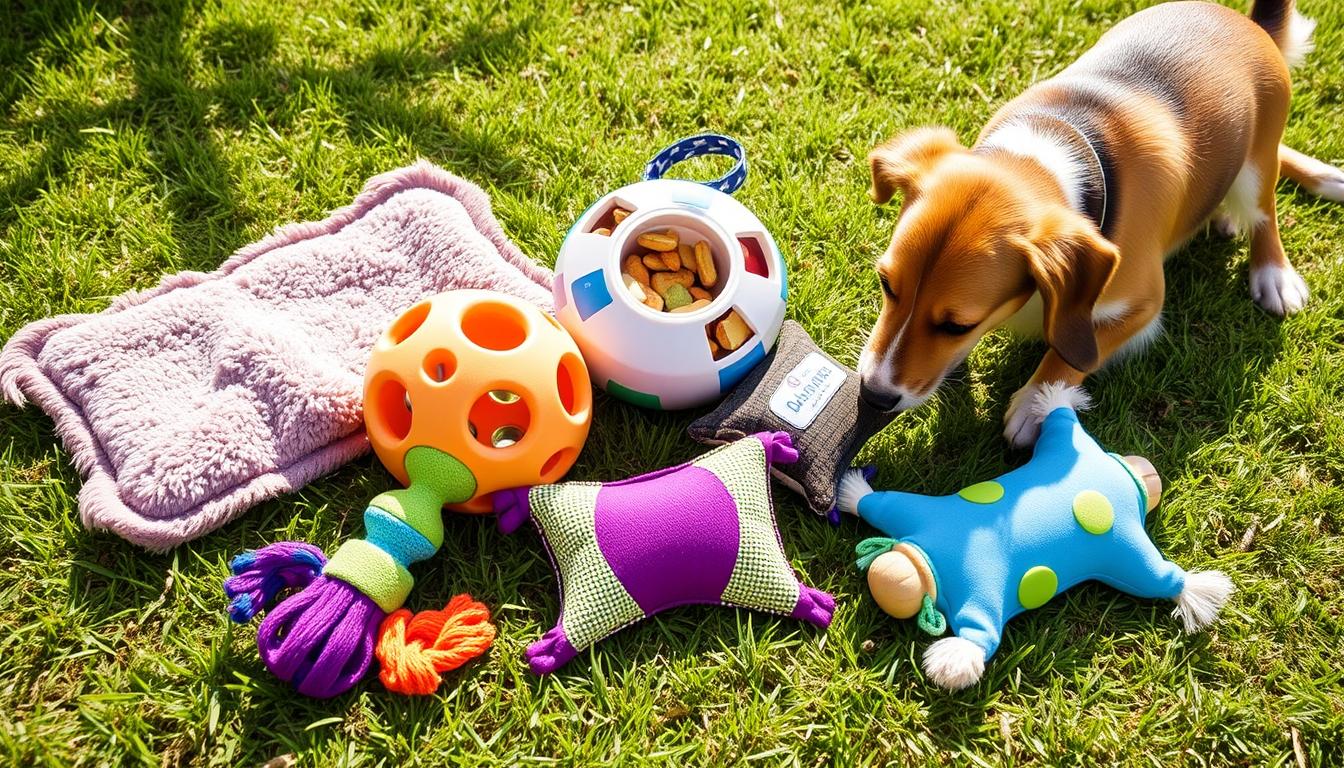As a dog owner, I’ve found that scent training toys are a game-changer. They make training fun and engaging for my dog. These toys provide mental stimulation and exercise, strengthening our bond.
Right scent training toys can challenge your dog’s sense of smell. They offer hours of fun, from simple games to complex puzzles. I’ll share my favorite picks that have greatly improved my dog’s life.
Why Scent Training is Beneficial for Dogs

Scent training is great for keeping your dog’s mind and body active. It offers many benefits for their health. Using scent work toys, you can challenge their sense of smell and keep their mind sharp.
Enhancing Their Natural Abilities
Dogs are naturally good at sniffing out scents. Scent training boosts this skill. Toys like puzzle toys and hide-and-seek games make it fun and challenging for them.
Providing Mental Stimulation
Scent work and mental stimulation toys are key for dogs’ mental health. They prevent boredom and stress. Adding these toys to your dog’s daily routine can make them happier and healthier.
Strengthening the Human-Dog Bond
Scent training is good for dogs and their owners too. It builds trust and communication. Working together on scent training activities makes your bond stronger and more rewarding.
Examples of scent work and mental stimulation toys include puzzle toys, snuffle mats, and hide-and-seek games. These toys make it fun and challenging for your dog to use their sense of smell. They also encourage mental stimulation.
| Toy Type | Description | Benefits |
|---|---|---|
| Interactive Puzzle Toys | Challenging toys that require problem-solving | Provides mental stimulation and reduces boredom |
| Snuffle Mats | Mats with hidden scents and treats | Encourages sense of smell and provides mental stimulation |
| Hide-and-Seek Games | Games that require dogs to find hidden scents and treats | Provides physical and mental stimulation and strengthens human-dog bond |
My Top 5 Scent Training Toys

As a dog owner, I’ve found scent training to be great for my dog’s mind and nose. I’ve tried many toys, and here are my top 5 picks. These toys are fun and challenging for my dog, making them a game-changer for his mental stimulation.
Here are my top 5 scent training toys:
- The PetSafe Snuffle Mat: A great introduction to scent work, this mat provides a fun and interactive way for dogs to use their noses.
- Outward Hound Hide-A-Squirrel Puzzle Toy: This toy challenges dogs to find hidden squirrels, providing mental stimulation and rewarding their sense of smell.
- TRIXIE Dog Activity Flip Board: This flip board offers a variety of hiding spots for treats, keeping dogs engaged and stimulated.
- Nina Ottosson by Outward Hound Puzzle Toy: A more advanced puzzle toy that requires dogs to use problem-solving skills to find hidden treats.
These toys have been a great addition to my dog’s playtime. They provide a fun and challenging way to engage their sense of smell and problem-solving skills. By adding puzzle toys for dogs, scent discrimination toys, and dog nose work toys to their routine, you can give your dog a fun and stimulating experience.
How to Introduce Scent Training to Your Dog

Introducing scent training to your dog can be fun and rewarding. Start with simple exercises like hiding treats or toys with a strong scent. This helps your dog improve their sense of smell and gain confidence.
Dog training toys, like interactive pet toys, are great for scent training. They challenge your dog and make training fun. Using these toys helps your dog solve problems and strengthens your bond.
For a successful scent training experience, use positive reinforcement like praise and rewards. As your dog gets better, add more challenges and new scents. This keeps them engaged and develops their sense of smell and love for learning.
Key Tips for Introducing Scent Training
- Start with simple exercises and gradually increase the difficulty level
- Use positive reinforcement techniques, such as praise and rewards
- Incorporate scent training toys, such as interactive pet toys, into your training routine
- Be patient and consistent, and remember to have fun with your dog
Follow these tips and use the right scent training toys to help your dog. Keep training sessions fun and rewarding. This way, your dog will love learning and have a strong sense of smell.
| Training Stage | Recommended Toys | Training Tips |
|---|---|---|
| Beginner | Scent training toys, such as snuffle mats | Start with simple exercises and use positive reinforcement |
| Intermediate | Interactive pet toys, such as puzzle toys | Gradually increase the difficulty level and introduce new scents |
| Advanced | Dog training toys, such as hide-and-seek toys | Challenge your dog with complex scents and puzzles |
Tips for Choosing the Right Scent Training Toy
Choosing the right scent training toy for my dog is important. I look at several factors to make sure I’m giving them the best. The right toy helps with mental stimulation and scent work, which is key for their brain and happiness.
I start by thinking about my dog’s size and breed. This helps me find the right scent work toys. For example, smaller dogs need toys with smaller scent holes. Larger dogs need bigger toys with harder scent challenges.
Key Considerations
- Interactive features: Look for toys with adjustable difficulty levels and multiple scent paths to keep my dog engaged and stimulated.
- Material safety and durability: Choose toys made from non-toxic, durable materials that can withstand my dog’s enthusiasm and chewing.
- Age and skill level: Select toys suitable for my dog’s age, breed, and skill level, ensuring they’re not too easy or too difficult.
By thinking about these things and picking the right toy, I give my dog a fun way to do scent work. It also helps their brain grow and stay healthy.
Ways to Use Scent Training Toys in Play
Exploring scent training with my dog has shown me the value of puzzle toys. Scent discrimination and dog nose work toys are key in our play. They boost mental stimulation and strengthen our bond.
Using these toys in different ways has greatly improved my dog’s confidence and focus.
Structured Training Sessions
In our training, I challenge my dog’s sense of smell with scent discrimination toys. I hide treats or toys with a specific scent for them to find. This not only sharpens their scent work but also makes learning fun.
Fun in the Backyard
In the backyard, we play a game with puzzle toys. I fill them with treats or kibble, and my dog must figure out how to get them out. It’s a fun way to keep their mind active and gives them a sense of achievement.
Incorporating Toys During Walks
During walks, I use dog nose work toys to keep my dog engaged. I hide treats or toys with a specific scent along the way. This activity keeps their mind sharp and helps them stay focused.
Adding puzzle toys, scent discrimination, and dog nose work toys to our play has greatly improved my dog’s behavior and well-being. These toys are now a vital part of our training and play, offering a fun way to exercise their mind and body.
Maintenance and Care of Scent Training Toys
To keep your scent training toys in good shape, follow some simple tips. Cleaning them regularly is key to avoid dirt and bacteria buildup. This can harm how well they work. I suggest washing them with mild soap and water, then drying them well to stop moisture buildup.
It’s also important to check your interactive pet toys for damage. Look for cracks or broken parts and replace them if needed. Storing them properly helps keep them organized and easy to find. Use a container or bag to store them.
Regular Cleaning Guidelines
- Wash your scent training toys with mild soap and water
- Dry them thoroughly to prevent moisture from accumulating
- Avoid using harsh chemicals or abrasive materials that can damage the toys
Inspecting for Wear and Tear
Check your dog training toys often for wear and tear. Replace them if you find any damage. This keeps them safe and working well, giving your dog the mental fun they need.
Common Mistakes to Avoid in Scent Training
Exploring scent training with my dog has taught me a lot. One key lesson is to avoid starting too advanced. This can cause frustration for both the dog and the owner. It’s important to introduce scent work toys and enrichment toys gradually.
This allows the dog to build confidence and skills. Scent training needs patience and persistence. Every dog learns at their own pace. Using mental stimulation toys like puzzle toys and hide-and-seek games can keep dogs engaged. But, they must be used consistently and in a way that challenges the dog without overwhelming them.
Some common mistakes to avoid in scent training include:
- Starting with complex exercises before mastering basic skills
- Failing to provide enough mental stimulation and variety in training sessions
- Not using positive reinforcement techniques to encourage good behavior
By avoiding these mistakes and using scent work toys, enrichment toys for dogs, and mental stimulation toys thoughtfully, owners can help their dogs develop strong scent work skills. This also strengthens the bond between the dog and their human family.
Conclusion: Making Scent Training a Fun Routine
Incorporating scent training toys into your dog’s playtime is rewarding for both you and your dog. Celebrate your dog’s progress and try new toys to keep training fun. This way, you meet your dog’s unique needs and keep them engaged.
Success in dog training comes from being positive, patient, and persistent. With time, your dog’s scenting skills will improve. This will strengthen your bond. So, enjoy the journey, pick creative toys, and make sure your dog has fun.

